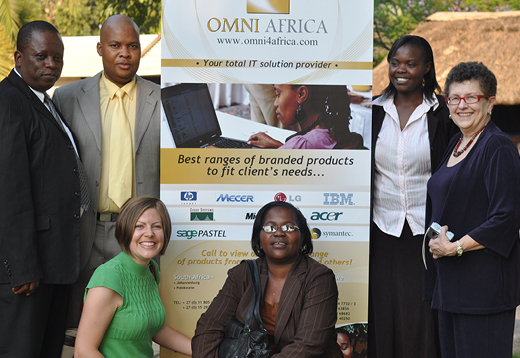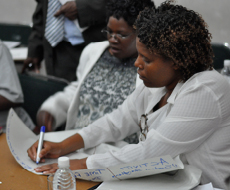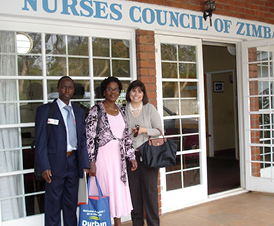Critical Conditions

The School of Nursing, the CDC, Georgia Tech, and Omni Africa, a computer hardware provider, are developing the Zimbabwe Human Resource Information System (ZHRIS) to track workforce data for nurses (see photo below) and other health professionals in that country. Project members include (above photo, L-R) C.M. Muchongwe and M. Mazhande (Omni Africa), Jessica Gross 09MSN/MPH and Noku Mujuru (ZHRIS/Emory), Otilia Nyamuzihwa (Omni Africa), and Judith Wold 81MN (ZHRIS/Emory).
|
|
EMORY, THE CDC, AND GEORGIA TECH:
Zimbabwe project assesses health workforce capacity
In a world struggling with a severe shortage of nurses, Zimbabwe stands out. The country once called the “breadbasket of Africa” has been decimated by economic, civil, and political unrest during the past decade. Well-trained health professionals have left the country, seeking a better standard of living for their families.
Zimbabweans also suffer one of the highest HIV infection rates worldwide—and health professionals are infected and dying at the same rapid rate as the rest of the population. More than 15% of adults under age 50 are HIV positive, according to the World Health Organization (WHO).
The first step toward solving Zimbabwe’s nursing shortage is to assess current workforce capacity, says Judith Wold 81MN, clinical professor with the nursing school’s Lillian Carter Center for International Nursing (LCCIN). “Without good information, you don’t know where you’re going,” she says. “Information is current reality, and good decisions can only be made based on that.”
Wold is collaborating with adjunct faculty member Patricia Riley of the CDC’s Division of Global HIV/AIDS and information experts with the Georgia Tech Research Institute to develop a computerized system for collecting human resources for health (HRH) data on the nation’s shrinking workforce. Funding for the project—the Zimbabwe Human Resource Information System (ZHRIS)—is provided by CDC Zimbabwe, supported by the U.S. President’s Emergency Plan for AIDS Relief (PEPFAR).
 |
Reliable information constantly updated in one consistent format lays the groundwork for sound health policy decisions anywhere, including the United States. The ZHRIS aims to accurately quantify the number of educated and registered health care professionals, including nurses, physicians, pharmacists, and lab technicians.
“You can’t have a health care system, much less improve it, without human resources,” Wold says. “It’s easy to talk about specific health care issues, but first we must know who the clinicians are, where they are, and how qualified they are—their education levels, experience, and skills and whether they passed licensure exams.”
The nursing workforce is woefully inadequate and underpaid throughout the developing world, but tackling the problem in Zimbabwe is especially difficult.
“We need to know whether registered clinicians are in the country and are able or willing to work,” Wold says. “The information the country has now is scattered and in many different formats. There is no unified system to track health professionals.”
|
“You can’t have a health care system, much less improve it, without human resources. It’s easy to talk about specific health care issues, but we first must know who the clinicians are, where they are, and how qualified they are.” |
||||
The effort builds on the success of the HRIS begun in Kenya in 2002 to collect and track nursing workforce data. LCCIN director Martha Rogers has led that project since 2006 and is helping guide the Zimbabwe project along a similar path. Today, Kenya’s Ministry of Health uses the HRIS developed by Rogers’s team to manage and deploy human resources and make policy decisions based on accurate and consistent data.
The workforce data provided by the Emory project helped convince Kenya’s Parliament to act to retain experienced nurses. “Kenyan health officials used the database information to advocate for raising the mandatory retirement age for nurses, which was 55,” says Rogers. “They knew they were going to lose many of their most experienced nurses in their prime, and Parliament raised the retirement age to 60.”
While Kenya and Zimbabwe have private health care sectors, the health care systems there largely are government owned and operated. The government also funds education for health care providers in both countries. Kenya’s HRIS includes data on nursing students and whether they graduate from nursing school.
|
Rankesh Willy (left) and Agnes Waudo of the Nursing Council of Zimbabwe with Patricia Riley of the CDC's Division of Global HIV/AIDS |
“If the government pays for their education, it’s important to know if nursing graduates stay to work in the country,” Rogers says. “We do know that large numbers of graduates are leaving the country—the quintessential brain drain.”
The Kenya database also includes quarterly reports from the nation’s eight provinces on the number of job vacancies and the number of people filling posts. Additionally, it connects with Ministry of Health human resource systems to monitor employee salaries—an important tool to protect against graft.
“They discovered a number of ghost workers—people who were dead or had left the country, yet someone was still collecting their paychecks,” says Rogers.
Health officials in Zimbabwe will benefit from the lessons learned in Kenya. This year, Wold’s team will develop a database for the Nursing Council of Zimbabwe, the nursing regulatory board, and also link electronically the council and the Ministry of Health and Child Welfare, the nation’s primary health agency. The launch of the ZHRIS will include an integrated HRH design to collect and retrieve workforce information on nurses. Data on physicians and other health professionals will be added as the ZHRIS progresses.
“We’re very hopeful that the system will have as great an impact in Zimbabwe as it has had in Kenya,” says Wold.
With time, the projects in Zimbabwe and Kenya should lead to the development of comparable workforce data systems in other low-resource countries, providing health experts with more timely and useful information worldwide.
“This way, we’ll compare apples to apples, not apples to oranges,” says Wold. “Funding agencies, including the U.S. government, spend a lot of money to fight global disease. Consistent, reliable data will help make sure that money is well spent for PEPFAR-supported initiatives.”
As in Kenya, the Zimbabwe project will involve nurses from the start. “Nurses are the primary caregivers in rural Africa,” Wold adds. “They are the largest health cadre and many times the only ones out in the field.”—Valerie Gregg and Pam Auchmutey




